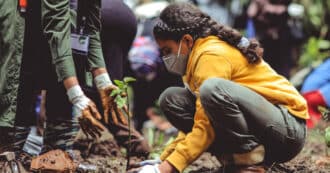By Harry Cooper – Everything we do requires an incredible amount of resources. Driving cars, eating food, building infrastructure, etc. all use natural resources that were once extracted from the world.
And with global populations continually rising, the world is demanding more and more natural resources to keep up with human and economic development. However, if we continue to extract natural resources in an unsustainable way, humanity and the environment will both be in big trouble.
The Need For Sustainable Resources
If we want to make sure that we have a prosperous future, it is important that we utilize sustainable resources. This will help us work towards practicing sustainable development.
However, it is often not enough to simply use renewable resources, as many of them can not replenish faster than we are currently using them. But by using more renewable resources, and using them in moderation, we can ensure that there will be enough resources to power our world and the world of future generations.
What Are Sustainable Resources?
For a resource to be sustainable it must meet two criteria. First, it must be renewable, and second, it must be managed responsibly.
In order for a resource to be renewable it must regenerate itself over time. But just because a resource is renewable doesn’t mean it will last forever.
Even renewable resources must be managed properly or they too can be depleted. In order to ensure that we have enough resources to last us for the foreseeable future, it is important to use them responsibly.
It is estimated that on average we use resources at 1.75 times the rate that the Earth can regenerate them. And as global populations increase, it is important, more now than ever, to make sure that we use our resources sustainably.
Sustainable Energy
One of the most important resources in the modern world is energy. But for the past few centuries we have relied very heavily on non renewable resources for energy, such as fossil fuels. If we want to ensure that we have enough energy to power human society in the future, we will need to make the switch to sustainable energy sources.
Our over reliance on fossil fuels is also a problem as they release greenhouse gas emissions and are the primary cause of climate change. If we don’t find a way to start using sustainable and renewable energy we will soon find ourselves in the middle of a planet-wide environmental disaster. But luckily there are a variety of other energy sources other than fossil fuels that are much more sustainable.
Sustainable Energy Sources
As long as the sun shines, the wind blows, the ocean tides move and the Earth’s core stays hot we will have reliable sources of energy at our disposal. Since renewable sources of extracting energy such as geothermal, wind, hydro and solar rely on energy sources that will never run out, we could hypothetically rely on them indefinitely.
Although, even though we have a variety of renewable energy sources at our disposal, they would still require some sustainable management in order to work as a large scale energy source. One of the biggest obstacles in implementing sustainable energy is the fact that solar, wind, and geothermal plants can only be built in places where there energy source is abundant. If a location can’t rely consistently on bright sunlight or strong winds, then solar panels and wind turbines would not be an effective means of getting energy.
On top of that, limitations in battery technology make storing and transporting energy difficult. In order to achieve a world with sustainable energy and end global warming we must be strategic about how we use every natural resource available to us.
Deforestation
One of the most significant resources that we currently use unsustainably is forests. For centuries humanity has relied on forests for valuable resources such as lumber, food, medicine, and other services, as well as acting as natural habitats for a variety of plants and animals.
But unfortunately, unsustainable forestry and land clearing for agriculture have caused forests to dwindle. It is estimated that around 18 million trees are lost each year from deforestation.
However, since lumber is a renewable resource there are ways to harvest it sustainably. By switching to sustainable practices in forestry methods we can enjoy the benefits of forests while maintaining a healthy environment.
Sustainable Forestry
Modern logging techniques involve clear cutting forests and removing all trees from the landscape, and effectively destroying the forest. However sustainable forestry techniques allow us to harvest wood while maintaining the forest’s health.
While cutting down trees may seem counterproductive to preserving a forest, when done in moderation forests are generally able to recover. By cutting down trees in a way that mimics the way trees would fall naturally in a forest, and allowing trees to regrow in their place, we are able to harvest lumber while sustainably maintaining the forest.
Sustainable Water Resources
While the world is made up of 75% water, less than one percent of it is available for human use because it is too salty or is trapped in glaciers. This makes it even more important that we protect what little freshwater we do have.
Earth’s hydrological cycles replenish water supplies and keep water renewable. However, this does not necessarily mean that we will always have water available for us.
Overconsumption of water causes droughts, and water pollution makes many supplies of freshwater unusable. This unsustainable usage of water leaves many parts of the world without access to clean water.
However, there are various techniques of using water that are fairly sustainable. By relying on these sustainable methods of using water, we can work to make sure more people have consistent access to clean water.
Rainwater Harvesting
Harvesting rainwater in rain barrels is a great way to sustainably use water. Collecting rainwater in barrels or other containers allows people to have a small, home supply of water that won’t deplete groundwater or other freshwater sources when used.
Desalination
Another way in which water can be used sustainably is through desalination. This process removes salt from seawater, making it drinkable. While the process is incredibly expensive and energy intensive, as desalination technology improves, more and more people will have access to clean water.
Sustainable Resources and Religion From Eco Bible Volume 2
Numbers 8:2 – Speak to Aaron and say to him, “When you mount the lamps, let the seven lamps give light at the front of the lampstand.”
Rabbi Shlomo ben Yitzchak (Rashi) teaches about the lighting of the oil lamp: “You must hold the light until you cause the flame to rise up by itself.” From this, we can learn about investing the proper time and resources for sustainable lighting. Although it may cost more, we value the means over the ends. The initial cost is worth the sustainable outcome. For example, despite the initial capital cost, LED lighting today saves money both by reducing electricity consumption and by less frequent bulb replacement.
The lighting of the biblical candelabrum was done with olive oil, a renewable resource. With sustainable energy, if we light our homes with fuels that don’t run out, we are causing our lights “to rise up by themselves.”
In 2018, 12.1 percent of world energy consumption came from renewables, and this capacity is growing at over 8 percent per year, avoiding 1.8 billion tons of carbon dioxide emissions per year. More and more municipalities are committing to all sustainable energy sources. However, global energy demand is also growing. As of 2019, renewables have yet to displace fossil fuels in the overall share of energy supply, which has remained constant over several decades at around 80 percent.
* Featured image source








